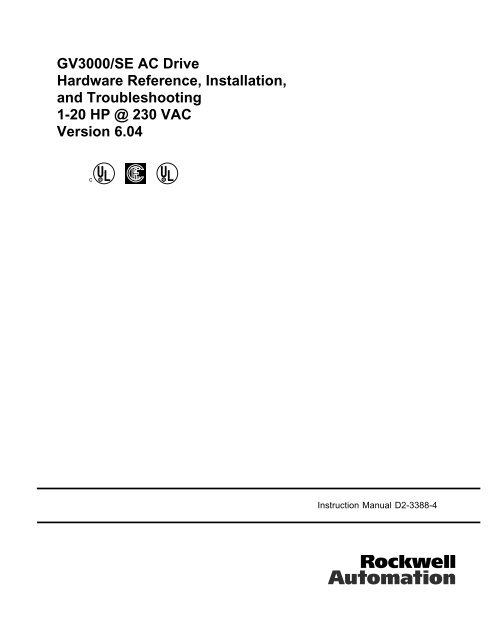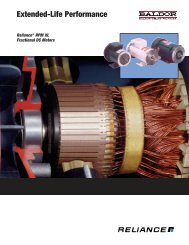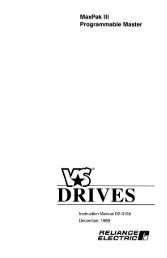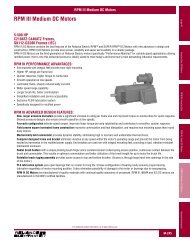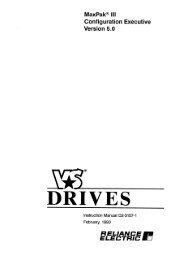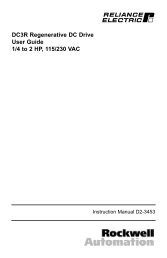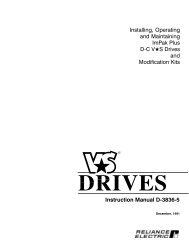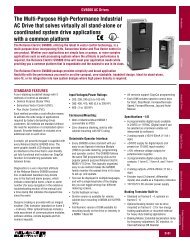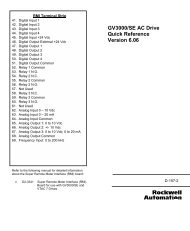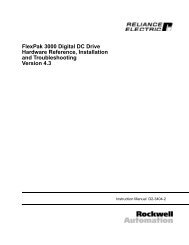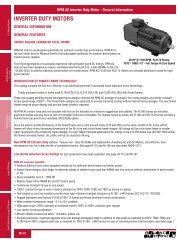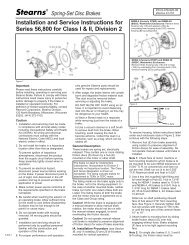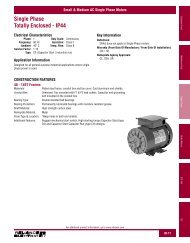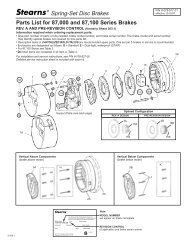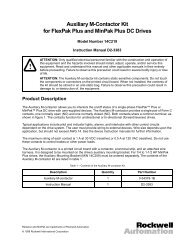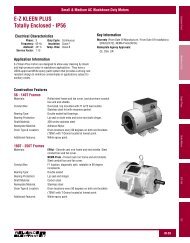GV3000/SE AC Drive Hardware Reference ... - Reliance Electric
GV3000/SE AC Drive Hardware Reference ... - Reliance Electric
GV3000/SE AC Drive Hardware Reference ... - Reliance Electric
- No tags were found...
You also want an ePaper? Increase the reach of your titles
YUMPU automatically turns print PDFs into web optimized ePapers that Google loves.
List of TablesTable 2.1 – Power Ratings .............................................................................. 2-2Table 2.2 – Available Kits and Options ........................................................... 2-13Table 3.1 – Ambient Conditions ...................................................................... 3-2Table 3.2 – <strong>Drive</strong> Dimensions and Weights .................................................... 3-2Table 3.3 – Recommended Power Wire Sizes for 1 to 5 HP <strong>Drive</strong>s ............... 3-4Table 3.4 – Recommended Power Wire Sizes for 7.5 and 10 HP <strong>Drive</strong>s ....... 3-5Table 3.5 – Recommended Power Wire Sizes for 15 and 20 HP <strong>Drive</strong>s ........ 3-5Table 3.6 – Recommended Terminal Strip Wire Sizes ................................... 3-5Table 3.7 – Motor Lead Lengths ...................................................................... 3-6Table 3.8 – Reactors ....................................................................................... 3-6Table 3.9 – <strong>AC</strong> Input Line Fuse Selection Values ........................................... 3-8Table 5.1 – <strong>AC</strong> Line Reactors ......................................................................... 5-2Table 7.1 – RS-232 Connections (Terminals 1-3) ........................................... 7-1Table 7.2 – Encoder Connections (Terminals 4-9).......................................... 7-1Table 7.3 – Analog Output Connections (Terminals 10 and 11) ..................... 7-2Table 7.4 – Analog Speed/Torque <strong>Reference</strong> Connections(Terminals 12-15) ......................................................................... 7-2Table 7.5 – Digital Input Connections (Terminals 16-25) ................................ 7-2Table 7.6 – Snubber Resistor Braking Connections (Terminals 26 and 27) ... 7-3Table 7.7 – Status Relay Connections (Terminals 28-31) .............................. 7-3Table 7.8 – Wiring Signal and Control I/O to the Terminal Strip ..................... 7-9Table 9.1 – Resistance Checks ....................................................................... 9-3Table 9.2 – Replacement Parts for 1-5 HP <strong>Drive</strong>s .......................................... 9-4Table 9.3 – Replacement Parts for 7.5-10 HP <strong>Drive</strong>s ..................................... 9-4Table 9.4 – Replacement Parts for 15-20 HP <strong>Drive</strong>s ...................................... 9-5Table A.1 – Service Conditions ........................................................................ A-1Table A.2 – Environmental Condition .............................................................. A-2Table A.3 – Terminal Strip Input Specifications ............................................... A-2Table A.4 – Terminal Strip Output Specifications ............................................ A-2Table A.5 – Terminal Strip RS-232 Specifications........................................... A-3Table A.6 – Encoder Feedback Device Specifications(FVC Regulation Only) ................................................................. A-3Table A.7 – Input Signal Response Times (Maximum) ................................... A-4Table of ContentsV
CHAPTER 1Becoming Familiar with the ManualThis chapter provides help in finding information in the manual and describes theintended audience. Also included are references to related publications andinstructions on receiving assistance from <strong>Reliance</strong> <strong>Electric</strong>.1.1 Finding InformationThis instruction manual describes the <strong>GV3000</strong>/<strong>SE</strong> drive's Power Module andregulator hardware. It does not cover the <strong>GV3000</strong>/<strong>SE</strong> software. For softwareinformation, refer to the <strong>GV3000</strong>/<strong>SE</strong> 230 V<strong>AC</strong> 1-20 HP General Purpose (V/Hz) andVector Duty <strong>Drive</strong> Software Start-Up and <strong>Reference</strong> Manual (D2-3387).As an aid in finding information in this manual, each chapter is briefly described below:• Chapter 1 - Becoming Familiar with the ManualProvides information on how the manual is organized and whereto find additional information.• Chapter 2 - About the <strong>Drive</strong>Identifies drive components and shows their locations.• Chapter 3 - Planning Before InstallingPresents information that must be considered when planning adrive installation.• Chapter 4 - Mounting the <strong>Drive</strong>, Grounding, and Finding Wire RoutingLocationsDescribes how to mount the drive and properly ground it.• Chapter 5 - Installing Input Power WiringDescribes incoming <strong>AC</strong> and DC line components and how toproperly connect them.• Chapter 6 - Installing Output Power WiringDescribes output <strong>AC</strong> line components and how to properlyconnect them to the motor.• Chapter 7 - Wiring the Regulator Board Terminal StripProvides information on the I/O wiring that connects to theterminal strip on the Regulator board.• Chapter 8 - Completing the InstallationProvides instructions on how to perform a final check of theinstallation before power is applied.• Chapter 9 - Troubleshooting the <strong>Drive</strong>Describes the equipment that is needed to troubleshoot the driveand how to measure DC bus voltage. A replacement part list isalso provided.Becoming Familiar with the Manual1-1
• Appendix A - Technical SpecificationsLists drive specifications in table form.1.2 Assumptions About the AudienceThis manual is intended for qualified electrical personnel. It is task-oriented and isorganized according to a logical progression of steps to be followed to install andtroubleshoot the drive.1.3 Understanding Terms Used in this ManualThe following terms are defined according to the way they are used in this manual:• <strong>GV3000</strong>/<strong>SE</strong> drives will typically be referenced by horsepower. If additionalclarity is required, drive model numbers will also be included.• Parameters will be referenced either as parameter (P.030) or Elapsed TimeMeter Reset (P.030).1.4 If You Want to Know MoreRefer to the following related publications as necessary for more information:• <strong>GV3000</strong>/<strong>SE</strong> 230 V<strong>AC</strong> 1-20 HP General Purpose (Volts/Hertz) and Vector Duty<strong>Drive</strong> Software Start-up and <strong>Reference</strong> manual (D2-3387).• Instruction manuals listed in Table 2.2.1.5 Getting Assistance from <strong>Reliance</strong> <strong>Electric</strong>If you have any questions or problems with the products described in this instructionmanual, contact your local <strong>Reliance</strong> <strong>Electric</strong> sales office. For technical assistance,call 1-800-726-8112.1-2 <strong>GV3000</strong>/<strong>SE</strong> 230 V<strong>AC</strong> 1-20 HP <strong>Drive</strong>, <strong>Hardware</strong> <strong>Reference</strong> Version 6.04
CHAPTER 2About the <strong>Drive</strong>This chapter describes how to identify the drive using the model number matrix andillustrates the differences between the NEMA enclosures. Major components ofeach drive group are also shown.The <strong>GV3000</strong>/<strong>SE</strong> <strong>AC</strong> drive is a PWM (Pulse-Width-Modulation) drive that providesvector and general purpose regulation for a wide range of applications.Using vector regulation, the drive can provide high dynamic response, maintain fullrated motor torque to zero speed, and precisely control motor speed in bothdirections. The drive can provide this functionality either with encoder feedback(flux vector control or FVC) or without (sensorless vector control or SVC).Using general purpose (volts/hertz or V/Hz) regulation, the drive is suited for abroad range of applications requiring adjustable speed control of motors.2.1 Identifying the <strong>Drive</strong> by Model NumberEach <strong>GV3000</strong>/<strong>SE</strong> <strong>AC</strong> drive can be identified by its model number. See figure 2.1.This number appears on the shipping label and on the drive's nameplate. Thedrive's model number includes the Power Module and the regulator. <strong>Drive</strong> powerratings are provided in table 2.1.Horsepower Ratings1 = 1 HP2 = 2 HP3 = 3 HP5 = 5 HP7 = 7.5 HP10 = 10 HP15 = 15 HP20 = 20 HP<strong>GV3000</strong>V = V/Hz or VectorNN V 2 N NNVoltage2 = 200 - 230 V<strong>AC</strong>Enclosure1 = NEMA 12 = NEMA 12 Only4 = NEMA 4X (Indoor Only) or NEMA 12Regulator Version60 = Vector and V/Hz RegulatorFigure 2.1 – Identifying the <strong>Drive</strong> Model NumberAbout the <strong>Drive</strong>2-1
ModelNumber1V21601V24602V21602V24603V21603V24605V21605V24607V21607V226010V216010V226015V216015V226020V216020V2260Input Volts(<strong>AC</strong>)200-230 V<strong>AC</strong>+/– 10%200-230 V<strong>AC</strong>+/– 10%200-230 V<strong>AC</strong>+/– 10%200-230 V<strong>AC</strong>+/– 10%200-230 V<strong>AC</strong>+/– 10%200-230 V<strong>AC</strong>+/– 10%200-230 V<strong>AC</strong>+/– 10%200-230 V<strong>AC</strong>+/– 10%NEMARating14X/1214X/1214X/1214X/12112112112112Table 2.1 – Power RatingsInputKVA2.43.75.59.612.715.524.129.8(1)With vector regulation, 150% output current capability for one minute.Input Amps(Maximum)6.1 A9.4 A13.8 A24.2 A31.9 A39.0 A60.5 A75.0 AOutput Amps(Maximum) (1)5.1 A8.5 A12.3 A21.0 A26.9 A35.0 A53.3 A69.6 APower Loss Watts(Full Load)601001401802102503756002.2 NEMA EnclosuresEach of the <strong>GV3000</strong>/<strong>SE</strong> Power Modules have one of the following NEMA ratings:• NEMA1: Vented. Contains a communication access door that allows access tothe communication port without removing the cover. Intended forgeneral-purpose indoor applications.• NEMA 4X/12: Not vented. Supplied with base and keypad gaskets. Intendedfor use in indoor environments that require a water-tight/dust-tight enclosure.An enclosure with this NEMA rating encompasses both ratings (4X and 12).• NEMA 12: Intended for use in indoor environments that require a dust-tight/drip-tight enclosure.See table 2.1 for a listing of the Power Modules and their individual NEMA ratings.2-2 <strong>GV3000</strong>/<strong>SE</strong> 230 V<strong>AC</strong> 1-20 HP <strong>Drive</strong>, <strong>Hardware</strong> <strong>Reference</strong> Version 6.04
1 2 3 4 5 6 7 8 9 10 11 12 13 14 15 16 17 18 19 20 21 22 23 24 25 26 27 28 29 30 312.3 1-20 HP <strong>GV3000</strong>/<strong>SE</strong> <strong>Drive</strong> Components and LocationsThe 1-20 HP <strong>GV3000</strong>/<strong>SE</strong> drives have the following main components. Theidentification numbers provided correspond to the number used in figures 2.2 to 2.4.Replacement parts are listed in chapter 9.1. Fan Assembly2. Membrane Switch (Keypad/Bracket)3. Regulator Printed Circuit Board4. Base Board (PISC Board)5. Base Board (GVPB Board)6. Internal Fan Assembly.1FAN AS<strong>SE</strong>MBLY2BA<strong>SE</strong> BOARD(PISC-5)4AUTO ForwardSPEED RUNNING MAN ReverseVOLTS REMOTEAMPS JOGPROGRAM RUNHzAUTOJOGKwFORWARDTORQUE REVER<strong>SE</strong>Password PROGRAM ENTERSTOPSTARTRE<strong>SE</strong>T6FAN AS<strong>SE</strong>MBLY(INTERNAL)MEMBRANE SWITCH(KEYPAD)/BR<strong>AC</strong>KET. ...3M/N1V21XX1V24XX2V21XX2V24XXM/N3V21XX3V24XX5V21XX5V24XXREGULATORBOARDFigure 2.2 – 1 to 5 HP <strong>Drive</strong> Components and LocationsAbout the <strong>Drive</strong>2-3
1 2 3 4 5 6 7 8 9 10 11 12 13 14 15 16 17 18 19 20 21 22 23 24 25 26 27 28 29 30 31PROGRAM1FAN AS<strong>SE</strong>MBLY4BA<strong>SE</strong> BOARD(PISC-10)SPEED RUNNINGVOLTS REMOTEAMPS JOGHzAUTOKwFORWARDTORQUE REVER<strong>SE</strong>Password PROGRAMSTOPSTARTRE<strong>SE</strong>TAUTO ForwardMAN ReverseENTERRUNJOG26MEMBRANE SWITCH(KEYPAD)/BR<strong>AC</strong>KETFAN AS<strong>SE</strong>MBLY(INTERNAL). ...3M/N7V21XX7V22XX10V21XX10V22XXREGULATORBOARDFigure 2.3 – 7.5 and 10 HP <strong>Drive</strong> Components and Locations2-4 <strong>GV3000</strong>/<strong>SE</strong> 230 V<strong>AC</strong> 1-20 HP <strong>Drive</strong>, <strong>Hardware</strong> <strong>Reference</strong> Version 6.04
1 2 3 4 5 6 7 8 9 10 11 12 13 14 15 16 17 18 19 20 21 22 23 24 25 26 27 28 29 30 31PROGRAM41FAN AS<strong>SE</strong>MBLYBA<strong>SE</strong> BOARD(PISC-20)5BA<strong>SE</strong> BOARD(GVPB-20)2SPEED RUNNINGVOLTS REMOTEAMPS JOGHzAUTOKwFORWARDTORQUE REVER<strong>SE</strong>Password PROGRAMSTOPSTARTRE<strong>SE</strong>TAUTO ForwardMAN ReverseENTERRUNJOG6FAN AS<strong>SE</strong>MBLY(INTERNAL)MEMBRANE SWITCH(KEYPAD)/BR<strong>AC</strong>KET. ...3M/N15V21XX15V22XX20V21XX20V22XXREGULATORBOARDFigure 2.4 – 15 and 20 HP <strong>Drive</strong> Components and LocationsAbout the <strong>Drive</strong>2-5
2.4 Regulator Board Description<strong>GV3000</strong>/<strong>SE</strong> drive regulation is performed by a microprocessor on the Regulatorboard. See figure 2.5. <strong>Drive</strong> operation is adjusted by the parameters enteredthrough the keypad. The Regulator board accepts power circuit feedback signalsand an external speed reference signal, as well as data from an encoder that isattached to the motor when set up for FVC regulation. The Regulator boardprovides:• PWM gating signals to the IGBT power devicesBased on the output of the control loop, the regulator sends PWM gating signalsthrough the Current Feedback board to isolated drivers on the Gate <strong>Drive</strong>rboard. These drivers switch the Insulated Gate Bi-polar Transistors (IGBTs),producing a pulse-width-modulated (PWM) waveform that corresponds to thespeed (FVC regulation) or frequency (volts/hertz regulation) reference. TheIGBTs can be switched at either a 2, 4 or 8 kHz carrier frequency.• Form A and B contacts for drive status indicatorsThe Form A and B contacts are under control of the user via programmableparameters. A Form A or B transition can indicate drive status. The contactsare rated for 5 amps resistive load at 250 V<strong>AC</strong>/ 30 VDC and are made availablethrough the terminal strip.• Display data for a four-character display and fourteen indicator LEDsThe four-character display is used to indicate drive parameters, parametervalues, and fault codes. The fourteen single LEDs indicate drive status andmode, as well as identifying drive outputs whose values are displayed on thefour-character display.• An analog outputThe analog output is a scaled voltage (0-10 VDC) or current (4-20 mA) signalproportional to either motor speed (RPM) or motor torque or current (%TORQUE).The current signal selection (via jumper J17) requires a power supply for operation.The power can be sourced from the encoder terminals (4 and 9) or from anexternal 15V power supply. See table 7.8, terminals 10 and 11, for moreinformation. The analog output signal is available through the terminal strip.• A snubber resistor braking signalThe Regulator board provides a signal for use by an optional snubber resistorbraking kit. The signal is available through the terminal strip.2-6 <strong>GV3000</strong>/<strong>SE</strong> 230 V<strong>AC</strong> 1-20 HP <strong>Drive</strong>, <strong>Hardware</strong> <strong>Reference</strong> Version 6.04
U<strong>SE</strong>R DISPLAYJ526-Pin Ribbon CableJ334-Pin Ribbon CableJ7J8J17 J4 U<strong>SE</strong>R I/O TERMINAL STRIPJ91 2 3 4 5 6 7 8 9 10 11 12 13 14 15 16 17 18 19 20 21 22 23 24 25 26 27 28 29 30 31J3 - Option Board ConnectorJ4 - Analog Input JumperJ5 - Power Module Feedback CableJ7 - OIM (optional) ConnectorJ8 - RS232C PortJ9 - Keypad/Display ConnectorJ17 - Analog Output JumperFigure 2.5 – Regulator Board Components and LocationsAbout the <strong>Drive</strong>2-7
2.4.1 Jumper Locations and SettingsJumpers J4 and J17 on the Regulator board are factory-set for voltage in andvoltage out signals. Refer to figure 2.5 for their locations on the Regulator board. Ifyou need to change the jumpers' settings, use the following procedures.!ATTENTION: Do not alter the setting of any jumper not described inthis instruction manual. Failure to observe this precaution could resultin damage to, or destruction of, the equipment.2.4.1.1 Analog Input Speed <strong>Reference</strong> Jumper (J4)Jumper J4 is the analog speed/torque (U.000) reference jumper. This jumperselects either +/– 10 VDC or 0-20 mA input . Parameters P.009, P.010, and P.011are used in conjunction with the jumper. Note that if the position of jumper J4 ischanged after the parameters are programmed, the software will not recognize thatthe input reference or polarity has been changed. Be sure to verify that parametersP.009, P.010, and P.011 are correct before starting the drive. Refer to the<strong>GV3000</strong>/<strong>SE</strong> Software Start-Up and <strong>Reference</strong> manual for more information.Use the following procedure to set jumper J4:!Step 1.Step 2.Step 3.ATTENTION: DC bus capacitors retain hazardous voltages after inputpower has been disconnected. After disconnecting input power, waitfive (5) minutes for the DC bus capacitors to discharge and then checkthe voltage with a voltmeter to ensure the DC bus capacitors aredischarged before touching any internal components. Failure to observethis precaution could result in severe bodily injury or loss of life.Turn off input power to the drive and wait five minutes.Remove the cover from the drive by unscrewing the two attaching screws.Verify that the DC bus voltage is zero by following the procedure in section9.3.Step 4. Locate jumper J4 on the Regulator board. Refer to figure 2.5.Step 5.Step 6.Step 7.Step 8.Locate pin 1 on jumper J4. Move the jumper to the desired setting asshown in figure 2.6.Reattach the cover.Reapply input power.Verify that the Terminal Strip Analog Input Offset (P.009), Terminal StripAnalog Input Gain (P.010), and Terminal Strip Analog Input Configure(P.011) are correctly set. Note that the jumper settings must match thesoftware settings otherwise the reference value may differ from what isexpected. Refer to the <strong>GV3000</strong>/<strong>SE</strong> Software Start-Up and <strong>Reference</strong>manual for more information.2-8 <strong>GV3000</strong>/<strong>SE</strong> 230 V<strong>AC</strong> 1-20 HP <strong>Drive</strong>, <strong>Hardware</strong> <strong>Reference</strong> Version 6.04
Voltage Input OptionPins 2-310 VDCCurrent Input OptionPins 1-20-20 mAJ4(default)J4Figure 2.6 – Jumper J4 Settings for Analog Input Speed <strong>Reference</strong>2.4.1.2 Analog Output Jumper (J17)Jumper J17 is the analog output jumper. This jumper selects either a 0-10 VDC or4-20 mA scaled signal output that is programmable for either speed or torque,parameter P.012. The jumper only selects a 0-10 VDC source voltage or 4-20 mAsink current to represent speed or torque. Note that the 4-20 mA current selectionrequires a power supply for operation as shown in table 7.8, terminals 10 and 11.Use the following procedure to set jumper J17:!Step 1.Step 2.Step 3.ATTENTION: DC bus capacitors retain hazardous voltages after inputpower has been disconnected. After disconnecting input power, waitfive (5) minutes for the DC bus capacitors to discharge and then checkthe voltage with a voltmeter to ensure the DC bus capacitors aredischarged before touching any internal components. Failure to observethis precaution could result in severe bodily injury or loss of life.Turn off input power to the drive and wait five minutes.Remove the cover from the drive by unscrewing the two attaching screws.Verify that the DC bus voltage is zero by following the procedure in section9.3.Step 4. Locate jumper J17 on the Regulator board. Refer to figure 2.5.Step 5.Step 6.Step 7.Step 8.Locate pin 1 on jumper J17. Move the jumper to the desired setting asshown in figure 2.7.Reattach the cover.Reapply input power.Verify that parameter P.012 is set correctly for either speed or current.About the <strong>Drive</strong>2-9
Voltage Output OptionPins 2-310 VDCCurrent Output OptionPins 1-24-20 mAJ17(default)J17Figure 2.7 – Jumper J17 Settings for Analog Outputs2.4.2 Wiring the Terminal StripThe terminal strip on the Regulator board provides terminals for connectingcustomer I/O devices. See figures 2.5 and 2.8. The following terminals areprovided:• Terminals 1-3 : RS-232 connections• Terminals 4-9 : encoder connections• Terminals 10-11: analog output connections• Terminals 12-15: analog speed/torque reference connections• Terminals 16-25: 24 VDC digital input connections• Terminals 26-27: snubber resistor braking control connections for olderSnubber Resistor Braking Kits (for example, the M/N 2DB2010 series)• Terminals 28-31: status relay connections2-10 <strong>GV3000</strong>/<strong>SE</strong> 230 V<strong>AC</strong> 1-20 HP <strong>Drive</strong>, <strong>Hardware</strong> <strong>Reference</strong> Version 6.04
TXRXREGULATOR COMMON+15 VDCPHA<strong>SE</strong> APHA<strong>SE</strong> A NOTPHA<strong>SE</strong> BPHA<strong>SE</strong> B NOTREGULATOR COMMONANALOG METER OUTPUTREGULATOR COMMONISOLATED REFERENCE VOLTAGEVDC SPEED REFERENCEmA SPEED REFERENCEISOLATED REFERENCE GND+24 VDCDIGITAL INPUT 8 (REMOTE/LOCAL)DIGITAL INPUT 7 (RAMP 1/RAMP 2)DIGITAL INPUT 6 (FORWARD/REVER<strong>SE</strong>)FUNCTION LOSSRUN/JOGRE<strong>SE</strong>TSTOPSTART+24 VDC COMMONSNUBBER RESISTOR BRAKING SIGNAL+24 VDC COMMONN.C. RELAY CONT<strong>AC</strong>TN.C. RELAY COMMONN.O. RELAY CONT<strong>AC</strong>TN.O. RELAY COMMON16 201 2 3 4 5 6 7 8 9 10 11 12 13 14 15 17 18 19 21 22 23 24 25 26 27 28 29 30 31RS-232CONNECTION<strong>SE</strong>NCODERCONNECTIONSANALOGOUTPUTANALOGSPEEDREFERENCECONFIGURABLEFactory InstalledSNUBBERBRAKINGSTATUSRELAYSDIGITAL INPUTS(ISOLATED 24 VDC)Figure 2.8 – Typical Terminal Strip Connections2.4.3 RS-232 Communication PortThe Regulator board contains a 9-pin D-shell RS-232 communication port (J8). Thisport provides RS-232 communication between the <strong>GV3000</strong>/<strong>SE</strong> drive and a personalcomputer running the Control and Configuration (CS3000) software. See figure 2.5.Refer to instruction manual D2-3348, for more information about the CS3000software.2.4.4 Option Board ConnectorThe flat-ribbon cable connector (J3) on the left side of the Regulator board is aparallel bus connection port that provides a means of attaching optional boardssuch as the DeviceNet Option board, the RMI board, the AutoMax Network Optionboard, or similar boards to the <strong>GV3000</strong>/<strong>SE</strong> drive. See figure 2.5. The option boardis mounted below the Regulator board inside the drive. Refer to the appropriate boardinstruction manual for more information. Refer to section 2.5 of this manual formore information on optional drive kits.2.4.5 Operator Interface Module ConnectorThe flat-ribbon connector J7 provides a means of attaching the optional OperatorInterface Module (OIM). The OIM is available for use as a remote keypad for the<strong>GV3000</strong>/<strong>SE</strong> drive.About the <strong>Drive</strong>2-11
2.4.6 Keypad/DisplayThe front panel keypad/display is used to program and operate the <strong>GV3000</strong>/<strong>SE</strong>drive. See figure 2.9. Refer to the <strong>GV3000</strong>/<strong>SE</strong> Software Start-Up and <strong>Reference</strong>manual for more information.<strong>Drive</strong> Status LEDsDisplayKeypadMonitor ModeLEDsPassword LED£. ¥SPEEDVOLTSAMPSHzKwTORQUEPasswordSTOPRE<strong>SE</strong>TRUNNINGREMOTEJOGAUTOFORWARDREVER<strong>SE</strong>PROGRAMSTARTAUTOMANPROGRAMENTERForwardReverseRUNJOGStop/ResetKeyStart KeyFigure 2.9 – Keypad/Display2-12 <strong>GV3000</strong>/<strong>SE</strong> 230 V<strong>AC</strong> 1-20 HP <strong>Drive</strong>, <strong>Hardware</strong> <strong>Reference</strong> Version 6.04
2.5 <strong>Drive</strong> Kit OptionsTable 2.2 provides a listing of the available <strong>GV3000</strong>/<strong>SE</strong> kit options.Kit Description (1)Snubber Resistor Braking (2)Motor Encoder CableControlNet Network Option BoardInterbus-S Network Option BoardAutoMax Network Option Boardwith 762 mm (30") of CableAutoMax RS-232 Adapter CableSuper Remote Meter Interface (RMI)DeviceNet Network Option BoardOperator Interface Module (OIM)CS3000 Control and ConfigurationSoftwareCS3000 RS-232 Computer Cable115 VDC Interface Option BoardPROFIBUS TM Interface BoardTable 2.2 – Available Kits and OptionsOption Kit ModelNumber2SR203002TC3025 (3)2TC3075 (3)2TC4025 (3)2TC4075 (3)2TC4100 (4)2TC4300 (4)2CN30002NB30002AX30002CA30012SI30002DV30002RK30002CS30002CA30002LB30002PB3000InstructionManualD2-3373D2-3305D2-339049'1333D2-3308D2-3348D2-3341HE-HGV3DND2-3342D2-3348D2-3348D2-337649.1355(1)Consult the factory for options desired when not shown. Option kits are subject to change forfeature or performance enhancements.(2)Up to two snubber kits can be connected to a drive in parallel.(3)These cables are for use with <strong>Reliance</strong> NEMA Vector Inverter Duty Motors (encoder connector andexposed wire pairs).(4)These cables are for use with <strong>Reliance</strong> NEMA Vector Inverter Duty Motors (exposed wire pairs onboth ends).About the <strong>Drive</strong>2-13
CHAPTER 3Planning Before InstallingThis chapter provides information that must be considered when planning a<strong>GV3000</strong>/<strong>SE</strong> drive installation. Installation site requirements, drive requirements,and wiring requirements are presented.!ATTENTION: Only qualified electrical personnel familiar with theconstruction and operation of this equipment and the hazards involvedshould install, adjust, operate, or service this equipment. Read andunderstand this manual and other applicable manuals in their entiretybefore proceeding. Failure to observe this precaution could result insevere bodily injury or loss of life.ATTENTION: When the level-sense start feature is enabled (P.054 =ON), the user must ensure that automatic start up of the drivenequipment will not cause injury to operating personnel or damage tothe driven equipment. In addition, the user is responsible for providingsuitable audible or visual alarms or other devices to indicate that thisfunction is enabled and the drive may start at any moment. Refer tothe <strong>GV3000</strong>/<strong>SE</strong> Software Start-Up and <strong>Reference</strong> manual foradditional information. Failure to observe this precaution could resultin severe bodily injury or loss of life.ATTENTION: Use of power correction capacitors on the output of thedrive can result in erratic operation of the motor, nuisance tripping,and/or permanent damage to the drive. Remove power correctioncapacitors before proceeding. Failure to observe this precaution couldresult in damage to, or destruction of, the equipment.ATTENTION: The user is responsible for conforming with all applicablelocal, national, and international codes. Failure to observe this precautioncould result in damage to, or destruction of, the equipment.3.1 Requirements for the Installation SiteIt is important to properly plan before installing a <strong>GV3000</strong>/<strong>SE</strong> drive to ensure that thedrive's environment and operating conditions are satisfactory. Note that no devices areto be mounted behind the drive. This area must be kept clear of all control and powerwiring. Read the following recommendations before continuing with drive installation.3.1.1 Making Sure Environmental Conditions are MetBefore deciding on an installation site, consider the following guidelines:• Verify that drives can be kept clean, cool, and dry.• The area chosen should allow the space required for proper air flow as definedin section 3.1.3.Planning Before Installing3-1
• Be sure that drives are away from oil, coolants, or other airborne contaminants.• Do not install the drive above 1000 meters (3300 feet) without derating outputpower. For every 91.4 meters (300 feet) above 1000 meters (3300 feet), deratethe output current 1%.• Verify that the drive location will meet the environmental conditions specified intable 3.1.Table 3.1 – Ambient ConditionsConditionOperating Temperature (Ambient)Storage Temperature (Ambient)HumiditySpecification0° to 40°C (32° to 104°F)–40° to +65°C (–40° to +149°F)5 to 95% (non-condensing)3.1.2 Determining Total Area Required Based on <strong>Drive</strong> Dimensions<strong>Drive</strong> dimensions and weights are listed in table 3.2. Overall dimensions areillustrated in figure 3.1 as an aid in calculating the total area required by the<strong>GV3000</strong>/<strong>SE</strong> drives.Table 3.2 – <strong>Drive</strong> Dimensions and Weights<strong>GV3000</strong>/<strong>SE</strong><strong>Drive</strong>Dim. ADim. BDim. CDim. DDim. EWeight1V21XX1V24XX2V21XX2V24XX3V21XX3V24XX5V21XX5V24XX222.3 mm8.75"280.7 mm11.05"198.1 mm7.80"254.3 mm10.01"199.9 mm7.87"6.4 kg14 lbs7V21XX7V22XX10V21XX10V22XX280.7 mm11.05"338.3 mm13.32"247.9 mm9.76"309.1 mm12.17"199.9 mm7.87"9.1 kg20 lbs15V21XX15V22XX20V21XX20V22XX288.0 mm11.34"463.0 mm18.23"223.0 mm8.78"442.0 mm17.40"238.0 mm9.37"15.9 kg3-2 <strong>GV3000</strong>/<strong>SE</strong> 230 V<strong>AC</strong> 1-20 HP <strong>Drive</strong>, <strong>Hardware</strong> <strong>Reference</strong> Version 6.04
PROGRAMPROGRAM<strong>AC</strong>E. . . .SPEEDVOLTSAMPSHzKwTORQUEPasswordRUNNINGREMOTEJOGAUTOFORWARDREVER<strong>SE</strong>PROGRAMSTOPSTARTRE<strong>SE</strong>TAUTOMANENTERForwardReverseRUNJOGDB<strong>GV3000</strong><strong>AC</strong> DRIVEFigure 3.1 – <strong>Drive</strong> Dimensions3.1.3 Verifying the Site Provides for Recommended Air Flow ClearancesBe sure there is adequate clearance for air ventilation around the drive. For best airmovement, do not mount <strong>GV3000</strong>/<strong>SE</strong> drives directly above each other. Note that nodevices are to be mounted behind the drive. This area must be kept clear of allcontrol and power wiring. Refer to figure 3.2 for recommended air flow clearances.100 mm (4 in.) IF ADJ<strong>AC</strong>ENT TO OTHER DRIVES,THIS CLEARANCE MUST BE250 MM (10 IN.).100 mm (4 in.)
3.1.4 Verifying Power Module <strong>AC</strong> Input Ratings Match Supplied PowerIt is important to verify that plant power will meet the input power requirements ofthe <strong>GV3000</strong>/<strong>SE</strong> drive's Power Module circuitry. Refer to table 2.1 for input powerrating specifications. Be sure input power to the drive corresponds to the drivenameplate voltage and frequency.3.2 Wiring Requirements for the <strong>Drive</strong>Certain drive requirements should be checked before continuing with the driveinstallation. Wire sizes, branch circuit protection, speed feedback (for FVCregulation), and E-stop wiring (see chapter 7), are all areas that need to beevaluated.3.2.1 Meeting Terminal Strip Input and Output SpecificationsThe terminal strip on the Regulator board provides terminals for 24 VDC power forthe eight remote control inputs. Refer to tables A.3 and A.4 for control input andoutput specifications.3.2.2 Determining Wire Size RequirementsWire size should be determined based on the size of conduit openings, applicablelocal, national, and international codes (e.g., NEC/CEC regulations).!ATTENTION: The user is responsible for conforming with allapplicable local, national, and international codes. Failure to observethis precaution could result in damage to, or destruction of, theequipment.3.2.2.1 Conduit Entry Opening SizesIt is important to accurately determine the size of the conduit openings so that thewire planned for a specific entry point will fit through the opening. Conduit openingsizes are shown in figures 4.1 through 4.3.3.2.2.2 Recommended Power Wire SizesInput power wiring should be sized according to applicable codes to handle thedrive's continuous-rated input current. Output wiring should be sized according toapplicable codes to handle the drive's continuous-rated output current. See tables3.3 to 3.5 for recommended power wire sizes.Important: Use only copper (Cu) wire with a temperature rating of 60/75°C.Table 3.3 – Recommended Power Wire Sizes for 1 to 5 HP <strong>Drive</strong>sType of Wiring<strong>AC</strong> Input PowerOutput PowerDC Input PowerGroundTerminalsR/L1, S/L2, T/L3U/T1, V/T2, W/T3+, –Size of Wire (Maximum)16 to 12 AWG(or 2 to 3.5 mm 2 )3-4 <strong>GV3000</strong>/<strong>SE</strong> 230 V<strong>AC</strong> 1-20 HP <strong>Drive</strong>, <strong>Hardware</strong> <strong>Reference</strong> Version 6.04
Type of Wiring<strong>AC</strong> Input PowerOutput PowerDC Input PowerGroundTable 3.4 – Recommended Power Wire Sizes for 7.5 and 10 HP <strong>Drive</strong>sTerminalsR/L1, S/L2, T/L3U/T1, V/T2, W/T3+, –Size of Wire (Maximum)10 to 8 AWG(or 5.5 to 8 mm 2 )Type of Wiring<strong>AC</strong> Input PowerOutput PowerDC Input PowerGroundTable 3.5 – Recommended Power Wire Sizes for 15 and 20 HP <strong>Drive</strong>sTerminalsR/L1, S/L2, T/L3U/T1, V/T2, W/T3+, –Size of Wire (Maximum)6 to 3 AWG(or 14 to 22 mm 2 )3.2.2.3 Recommended Control and Signal Wire SizesThe recommended wire size to connect I/O signals to the terminal strip on theRegulator board are shown in table 3.6. Recommended terminal tightening torqueis 0.5 Newton-meters (4.5 in-lb). Operator controls can be up to 303 meters (1000feet) from the <strong>GV3000</strong>/<strong>SE</strong> drive.Table 3.6 – Recommended Terminal Strip Wire SizesTerminals1 to 31Wire Size20 to 14 AWG (or 0.5 to 2 mm 2 )3.2.2.4 Recommended Motor Lead LengthsThe following motor lead lengths are recommended to reduce line disturbances andnoise. See figure 3.3.• For applications using one motor, motor lead length should not exceed 76meters (250 feet). Note that drives using vector regulation can only beconnected to one motor at a time.• For applications with multiple motors, total motor lead length should not exceed76 meters (250 feet).When total lead length exceeds 76 meters (250 feet), nuisance trips can occur,caused by capacitive current flow to ground. Note that these capacitively-coupledcurrents should be taken into consideration when working in areas where drives arerunning. If the motor lead length must exceed these limits, the addition of output linereactors or other steps must be taken to correct the problem. See table 3.7 and 3.8.Note that the motor lead lengths shown in table 3.7 are only guidelines. Yourapplication may be restricted to shorter lead length due to:• the type of wire• the placement of wire (for example, in conduit or a cable tray)• the type of line reactor• the type of motor.Planning Before Installing3-5
<strong>GV3000</strong>/<strong>SE</strong><strong>Drive</strong><strong>GV3000</strong>/<strong>SE</strong><strong>Drive</strong><strong>GV3000</strong>/<strong>SE</strong><strong>Drive</strong><strong>GV3000</strong>/<strong>SE</strong><strong>Drive</strong>38 m (125') 38 m (125')15 m (50')Motor61 m (200')61 m (200')76 m (250')MotorMotor8 m (25')8 m (25')Motor Motor Motor MotorAll examples represent 76 m (250') of motor lead length.Figure 3.3 – How to Measure Motor Lead LengthsTable 3.7 - Motor Lead Lengths<strong>GV3000</strong>/<strong>SE</strong>HP Rating1 to 23 to 57.5 to 1015 to 201 to 23 to 57.5 to 1015 to 20Maximum Lead Length in Feet with230 V<strong>AC</strong> MotorCarrier FrequencyFilter Type 2 kHz 4 kHZ 8 kHZ500500500None500500500750500500800500500A 5% MTEreactor/filter at thedrive.100010001000100010001000100010001000100010001000Note that the lead lengths listed are valid with <strong>Reliance</strong> <strong>Electric</strong> inverter duty motors.Table 3.8 - Reactors<strong>GV3000</strong>/<strong>SE</strong>HP Rating240 Volt5% MTE Reactor<strong>GV3000</strong>/<strong>SE</strong>HP Rating240 Volt5% MTE Reactor1235RL-00402RL-00802RL-01202RL-018027.5101520RL-02502RL-03502RL-04502RL-05502These part numbers are for a reactor with a capacitor filter.MTE standard reactors can be used on <strong>GV3000</strong>/<strong>SE</strong> drives with carrier frequency settings up to 8 kHZ.All reactors listed are UL-recognized (UL-506 File #E53094) and CSA certified (CSA File #LR29753).3-6 <strong>GV3000</strong>/<strong>SE</strong> 230 V<strong>AC</strong> 1-20 HP <strong>Drive</strong>, <strong>Hardware</strong> <strong>Reference</strong> Version 6.04
3.2.2.5 Recommended Serial Communication Cable LengthsConnector J8 on the Regulator boards is an RS-232 serial communication port.This connector allows the <strong>GV3000</strong>/<strong>SE</strong> drive to communicate with external devicessuch as a personal computer using RS-232 protocol. See table A.5.Two RS-232 cables are available from <strong>Reliance</strong>: a 3 meter (10 feet) D-shell 9-pin to9-pin cable (M/N 2CA3000) and a 0.3 meter (1 foot) D-shell 9-pin to 25-pin adaptercable (M/N 2CA3001). User-constructed cables can be up to 15 meters (50 feet) inlength.Note that for communication between a <strong>GV3000</strong>/<strong>SE</strong> drive and a personal computer,the Control and Configuration Software must also be used. Refer to instructionmanual D2-3348 for more information about the CS3000 Software.The Regulator boards have one set of RS-232 transmit/receive lines. These linescan be accessed by only one device at a time: connector J8, the RS-232 terminals(1-3) on the terminal strip, or an Operator Interface Module (OIM).3.2.3 Selecting <strong>AC</strong> Input Line Branch Circuit Fuses!ATTENTION: Most codes require that upstream branch circuitprotection be provided to protect input power wiring. Install the fusesrecommended in table 3.9. Do not exceed the fuse ratings. Failure toobserve this precaution could result in damage to, or destruction of,the equipment.Input line branch circuit protection fuses must be used to protect the input powerlines. See figures 5.1 and 5.2. Recommended fuse values are shown in table 3.9.The input fuse ratings listed in table 3.9 are applicable for one drive per branchcircuit. No other load may be applied to that fused circuit.Planning Before Installing3-7
Table 3.9 – <strong>AC</strong> Input Line Fuse Selection ValuesHorsepowerModel NumberRating1V21601 HP1V24602V21602 HP2V24603V21603 HP3V24605V21605 HP5V24607V21607.5 HP7V226010V216010 HP10V226015V216015 HP15V226020V216020 HP20V2260(1)Recommended fuse type: UL Class J, 600V, time-delay, or equivalent.Input <strong>AC</strong> FuseRating (1)12 A15 A20 A40 A50 A70 A100 A125 A3.2.4 Meeting Encoder Specifications (FVC Regulation Only)<strong>GV3000</strong>/<strong>SE</strong> drives set up for FVC regulation require an encoder for closed loopoperation. Encoder specifications are provided in table A.6. <strong>Drive</strong>s set up for V/Hzor SVC regulation do not require an encoder for feedback because they operate inopen loop mode.3.2.4.1 Encoder Wiring GuidelinesEncoder connections are considered signal level wiring and, therefore, must be runseparate from control and power wiring. <strong>Reliance</strong> <strong>Electric</strong> recommends 18 AWGunshielded twisted pair wires with 2-3 twists per inch for applications to a maximumdistance of 303 meters (1000 feet). The recommended <strong>Reliance</strong> <strong>Electric</strong> partnumber is 417900-207CG, 18 AWG, 6 conductor (3 twisted pairs).3.2.5 Verifying Power Module Output Current Rating is Greater ThanMotor Full Load AmpsVerify that the <strong>GV3000</strong>/<strong>SE</strong> output current rating is greater than the motor's full loadcurrent (amps). Table 2.1 lists the output current values.3-8 <strong>GV3000</strong>/<strong>SE</strong> 230 V<strong>AC</strong> 1-20 HP <strong>Drive</strong>, <strong>Hardware</strong> <strong>Reference</strong> Version 6.04
CHAPTER 4Mounting the <strong>Drive</strong>, Grounding, andFinding Wire Routing LocationsThis chapter shows how to mount the drive and properly ground it. Also shown arethe conduit entry areas where wiring is to be routed in and out of the drive.4.1 Mounting the <strong>Drive</strong>Attach the drive to the vertical surface selected using the four (4) mounting holesprovided. In order to maintain a flat mounting surface and to ensure that bolttightness is maintained, use washers under the bolt heads. Refer to figure 3.1 andtable 3.2 for drive mounting dimensions. Use the following user-supplied mountingbolts and washers:• 1 to 5 HP drives: M6 (1/4")• 7.5 and 10 HP drives: M8 (5/16")• 15 and 20 HP drive: M8 or M10 (5/16" or 3/8").4.1.1 Verifying the <strong>Drive</strong>'s Watts Loss RatingWhen mounting the drive inside of another enclosure, you should determine thewatts loss rating of the drive from table 2.1. This table lists the typical full loadpower loss watts value under all operating carrier frequencies. Ensureadequate ventilation is provided based on the drive's watts loss rating.4.2 Routing Input, Motor Output, Ground, and ControlWiring for the <strong>Drive</strong>All wiring should be installed in conformance with the applicable local, national, andinternational codes (e.g., NEC/CEC). Signal wiring, control wiring, and power wiringmust be routed in separate conduits to prevent interference with drive operation.Note that no wires are to be routed behind the drive. Use grommets, when hubs arenot provided, to guard against wire chafing. Figures 4.1 to 4.3 show the wirerouting, grounding terminals, and power terminal strips of the <strong>GV3000</strong>/<strong>SE</strong> drives.!ATTENTION: Do not route signal and control wiring with power wiringin the same conduit. This can cause interference with drive operation.Failure to observe this precaution could result in damage to, ordestruction of, the equipment.Mounting the <strong>Drive</strong>, Grounding, and Finding Wire Routing Locations4-1
Do not route more than three sets of motor leads through a single conduit. This willminimize cross-talk that could reduce the effectiveness of noise reduction methods.If more than three drive/motor connections per conduit are required, shielded cablemust be used. If possible, each conduit should contain only one set of motor leads.!ATTENTION: Unused wires in conduit must be grounded at both endsto avoid a possible shock hazard caused by induced voltages. Also, ifa drive sharing a conduit is being serviced or installed, all drives usingthis conduit should be disabled to eliminate the possible shock hazardfrom cross-coupled motor leads. Failure to observe these precautionscould result in bodily injury.4.3 Grounding the <strong>Drive</strong>!ATTENTION: The user is responsible for conforming with allapplicable local, national, and international codes. Failure to observethis precaution could result in damage to, or destruction of, theequipment.Use the following steps to ground the drive:Step 1.Step 2.Step 3.Remove the drive's cover.Run a suitable equipment grounding conductor unbroken from the drive'sground terminal to the motor's ground terminal and then to earth ground.See figures 4.1 to 4.3, 5.1 and 5.2.Connect a suitable grounding conductor to the motor frame, the remotecontrol station (if used), and the transformer. Run each conductorunbroken to earth ground.When adding more than one grounding conductor wire to a single chassisground, twist the conductors together.Step 4.Reattach the drive's cover.4-2 <strong>GV3000</strong>/<strong>SE</strong> 230 V<strong>AC</strong> 1-20 HP <strong>Drive</strong>, <strong>Hardware</strong> <strong>Reference</strong> Version 6.04
. . . .SPEEDVOLTSAMPSHzKwTORQUEPasswordSTOPRE<strong>SE</strong>TRUNNINGREMOTEJOGAUTOFORWARDREVER<strong>SE</strong>PROGRAMSTARTAUTOMANPROGRAMENTERForwardReverseRUNJOGREGULATOR TERMINALSTRIP16 20POWER TERMINALSTRIPGROUND TERMINALSIGNAL CONTROL(TERMINAL STRIP)SIGNAL CONTROL- OR -SNUBBER RESISTORBRAKINGINPUT POWERAND MOTOR LEADSU<strong>SE</strong>R WIRE ROUTINGCOVERBA<strong>SE</strong>Bottom View(3) 1/2" NPTCONDUIT HUBS (NEMA 4X/12).-OR-(3) 0.875 [22.2 mm] DIA.HOLES (NEMA 1).Figure 4.1 – Wire Routing Locations for 1 to 5 HP <strong>Drive</strong>sMounting the <strong>Drive</strong>, Grounding, and Finding Wire Routing Locations4-3
. . . .SPEEDVOLTSAMPSHzKwTORQUEPasswordSTOPRE<strong>SE</strong>TAUTORUNNING MANREMOTEJOGAUTO PROGRAMFORWARDREVER<strong>SE</strong>PROGRAMSTARTENTERForwardReverseRUNJOGREGULATOR TERMINALSTRIP16 20POWER TERMINALSTRIPGROUND TERMINALSSIGNAL CONTROL INPUT POWER(TERMINAL STRIP) - OR -SNUBBER RESISTORBRAKINGMOTOR LEADS- OR -INPUT POWERAND MOTOR LEADSU<strong>SE</strong>R WIRE ROUTING(1) 1/2" NPTCONDUIT HUB (NEMA 12)-OR-(1) 0.875 [22.2 mm] DIA.HOLES (NEMA 1).COVERBA<strong>SE</strong>Bottom View(3) 3/4" NPTCONDUIT HUBS (NEMA 12).-OR-(3) 0.875 [22.2 mm] DIA.HOLES (NEMA 1).Figure 4.2 – Wire Routing Locations for 7.5 and 10 HP <strong>Drive</strong>s4-4 <strong>GV3000</strong>/<strong>SE</strong> 230 V<strong>AC</strong> 1-20 HP <strong>Drive</strong>, <strong>Hardware</strong> <strong>Reference</strong> Version 6.04
. . . .AUTO ForwardSPEED RUNNING MAN ReverseVOLTS REMOTEAMPS JOGPROGRAM RUNHzAUTOJOGKwFORWARDTORQUE REVER<strong>SE</strong>Password PROGRAM ENTERSTOPSTARTRE<strong>SE</strong>TREGULATOR TERMINALSTRIP16 20POWER TERMINALSTRIPGROUND TERMINALSSIGNAL CONTROL INPUT POWER(TERMINAL STRIP) - OR -SNUBBER RESISTORBRAKINGMOTOR LEADS- OR -INPUT POWERAND MOTOR LEADSU<strong>SE</strong>R WIRE ROUTING(1) 1/2" NPTCONDUIT HUBS (NEMA 12).-OR-(1) 0.875 [22.2 mm] DIA.HOLES (NEMA 1).COVERBA<strong>SE</strong>(3) 1-1/4" NPTCONDUIT HUBS (NEMA 12)-OR-(3) 1.60 [40.6 mm] DIA.HOLES (NEMA 1)Bottom ViewFigure 4.3 – Wire Routing Locations for 15 and 20 HP <strong>Drive</strong>sMounting the <strong>Drive</strong>, Grounding, and Finding Wire Routing Locations4-5
CHAPTER 5Installing Input Power WiringThis chapter describes incoming line components and how to install them.5.1 Installing Transformers and Reactors (Optional)Input isolation transformers might be needed to help eliminate the following:• Damaging line voltage transients from reaching the drive.• Line noise from the drive back to the incoming power source.• Damaging currents that could develop if a point inside the drive becomesgrounded.Observe the following guidelines when installing an isolation transformer:• A power disconnecting device must be installed between the power line and theprimary of the transformer.• If the power disconnecting device is a circuit breaker, the circuit breaker triprating must be coordinated with the inrush current (10 to 12 times full loadcurrent) of the transformer.• An input isolation transformer rated more than 500 KVA for 230 V<strong>AC</strong> with lessthan 5% impedance should NOT be used directly ahead of the drive withoutadditional impedance between the drive and the transformer.!ATTENTION: Distribution system capacity above the maximumrecommended system KVA (500 KVA for 230 V<strong>AC</strong>) requires the use ofan isolation transformer, a line reactor, or other means of addingsimilar impedance to the drive power input. Failure to observe theseprecautions could result in damage to, or destruction of, the equipment.ATTENTION: When the <strong>AC</strong> line is shared directly with otherSCR-rectified drives, an optional snubber resistor braking kit might berequired to alleviate excess DC bus voltage. Failure to observe theseprecautions could result in damage to, or destruction of, the equipment.The <strong>GV3000</strong>/<strong>SE</strong> <strong>AC</strong> line distribution system capacity is 500 KVA, three-phase with30,000 amps symmetrical fault current capacity with a line impedance of less than5%. The symmetrical fault current may be increased to 85,000 amps if the appropriatethree-phase <strong>AC</strong> line reactor is used as shown in table 5.1.Installing Input Power Wiring5-1
Table 5.1 – <strong>AC</strong> Line Reactors<strong>GV3000</strong>/<strong>SE</strong> <strong>Drive</strong>1 HP2 HP3 HP5 HP7.5 HP10 HP15 HP20 HPLine Reactor Inductance (+/–10%)1.68 mH1.08 mH720 µH432 µH360 µH270 µH180 µH135 µH5.2 Installing Fuses for Branch Circuit ProtectionInstall the required, user-supplied branch circuit protection fuses according to theapplicable local, national, and international codes (e.g., NEC/CEC). The fuses mustbe installed in the line before the drive input terminals. See figures 5.1 and 5.2.Fuse value selections are provided in table 3.7.!ATTENTION: Most codes require that upstream branch protection beprovided to protect input power wiring. Failure to observe thisprecaution could result in severe bodily injury or loss of life.5.3 Installing a Required External/Separate Input DisconnectAn input disconnect must be installed in the line before the drive input terminals inaccordance with local, national, and international codes (e.g., NEC/CEC). Thedisconnect should be sized according to the in-rush current as well as any additionalloads the disconnect might supply. The trip rating for the inrush current (10-12times full load current) should be coordinated with that of the input isolationtransformer, if used. Refer to section 5.1 for additional information.5-2 <strong>GV3000</strong>/<strong>SE</strong> 230 V<strong>AC</strong> 1-20 HP <strong>Drive</strong>, <strong>Hardware</strong> <strong>Reference</strong> Version 6.04
3-Phase <strong>AC</strong>Input Voltage 230 V181 182 183 GNDManualDisconnectFuseUser-Supplied<strong>AC</strong> ReactorR S T1L1 1L2 IL3‘ –GND(PE)–‘ <strong>GV3000</strong>/<strong>SE</strong>Power ModuleU V WGNDUser-SuppliedMotor Overload Relay(Optional if ElectronicOverload is Used)MFigure 5.1 – Typical <strong>AC</strong> Input <strong>Electric</strong>al ConnectionsInstalling Input Power Wiring5-3
DC InputVoltage 310 V NominalManualDisconnectDC FuseUser-SuppliedR S T1L1 1L2 IL3‘ –GND(PE)4547–‘ <strong>GV3000</strong>/<strong>SE</strong>Power ModuleU V WGNDUser-SuppliedMotor Overload Relay(Optional if ElectronicOverload is Used)MFigure 5.2 – Typical DC Bus <strong>Electric</strong>al Connections5-4 <strong>GV3000</strong>/<strong>SE</strong> 230 V<strong>AC</strong> 1-20 HP <strong>Drive</strong>, <strong>Hardware</strong> <strong>Reference</strong> Version 6.04
5.4 Installing Power Wiring from the <strong>AC</strong> Input Line to the<strong>Drive</strong>'s Power TerminalsUse the following steps to connect <strong>AC</strong> input power to the drive:Step 1.Wire the <strong>AC</strong> input power leads by routing them according to drive type. Referto figures 4.1 to 4.3. Tables 3.3 to 3.5 contain the recommended power wiringsizes.On 1 to 5 HP drives, route the power leads through the bottom rightopening of the drive base.On 7.5 to 20 HP drives, route the power leads through the bottommiddle-right opening of the drive base. If the snubber resistor brakingoption is used, route the power leads through the bottom right opening.!Step 2.ATTENTION: Do not route signal and control wiring in the sameconduit with power wiring. This can cause interference with driveoperation. Failure to observe this precaution could result in damageto, or destruction of, the equipment.Connect the three-phase <strong>AC</strong> input power leads (three-wire 200-230 V<strong>AC</strong>)to terminals R/L1, S/L2, T/L3 on the power terminal strip.Step 3. Tighten the <strong>AC</strong> input power terminals to 1.2-1.4 Newton-meters (10-12lb-in) for 1-5 HP drives, 2.0-2.4 Newton-meters (17-20 lb-in) for 7.5 and 10HP drives, and 2.5-2.9 Newton-meters (22-26 lb-in) for 15 and 20 HPdrives.5.5 Installing Power Wiring from an External DC Bus to the<strong>Drive</strong>'s Internal DC Bus TerminalsUse the following steps to connect DC input power to the drive:Step 1.Wire the DC input power leads by routing them according to drive type. Referto figure 4.1 to 4.3. Tables 3.3 to 3.5 contain the recommended power wiringsizes.On 1 to 5 HP drives, route the power leads through the bottom rightopening of the drive base.On 7.5 to 20 HP drives, route the power leads through the bottommiddle-right opening of the drive base. If the snubber resistor option isused, route the power leads through the bottom right opening.Installing Input Power Wiring5-5
!ATTENTION: Do not route signal and control wiring in the sameconduit with power wiring. This can cause interference with driveoperation. Failure to observe this precaution could result in damageto, or destruction of, the equipment.ATTENTION: If the <strong>GV3000</strong>/<strong>SE</strong> drive is connected to an external DCbus, the user is responsible for DC bus short-circuit protection. Failureto observe this precaution could result in damage to, or destruction of,the equipment.Step 2. Connect the DC input power leads (two-wire 310 VDC nominal) toterminals + and – on the power terminal strip.Note that the maximum discharge rate of the DC bus supply should be100 V/second.Step 3. Tighten the DC input power terminals to 1.2-1.4 Newton-meters (10-12lb-in) for 1-5 HP drives, 2.0-2.4 Newton-meters (17-20 lb-in) for 7.5 and 10HP drives, and 2.5-2.9 Newton-meters (22-26 lb-in) for 15 and 20 HPdrives.5-6 <strong>GV3000</strong>/<strong>SE</strong> 230 V<strong>AC</strong> 1-20 HP <strong>Drive</strong>, <strong>Hardware</strong> <strong>Reference</strong> Version 6.04
CHAPTER 6Installing Output Power WiringThis chapter provides instructions on wiring output contactors, motor overloadprotection, and output wiring to the motor.6.1 Installing Output Contactors (Optional)Output contactors provide a positive means of disconnecting the motor from thedrive. If the application requires the use of output contactors, contact <strong>Reliance</strong><strong>Electric</strong> for assistance.6.2 Installing Mechanical Motor Overload Protection(Optional)To provide the motor with overload protection, local, national, and internationalcodes (e.g., NEC/CEC) require that a motor thermostat, internal to the motor, beinstalled or an electronic thermal motor overload relay, sized to protect the motor,be installed between the motor and the drive's output terminals.The Motor Overload Enable parameter (P.040) can be used in place of thethermal motor overload relays in single motor applications. Note, however, thattemperature measuring devices integral to the motor are the best way to thermallyprotect <strong>AC</strong> motors under all conditions. Parameter P.040 must be enabled toprovide overload protection. Refer to the <strong>GV3000</strong>/<strong>SE</strong> Software Start-Up and<strong>Reference</strong> manual for more information.In multiple motor applications (V/Hz regulation only), each motor must have its ownuser-supplied overload protection.6.3 Installing Output Wiring from the <strong>Drive</strong> Output Terminalsto the MotorUse the following steps to connect the <strong>AC</strong> output power wiring from the drive to themotor:Step 1.Wire the three-phase <strong>AC</strong> output power motor leads by routing themaccording to drive type. Refer to figures 4.1 to 4.3. Tables 3.3 to 3.5contain the recommended power wiring sizes.Do not route more than three sets of motor leads through a single conduit.This will minimize cross-talk that could reduce the effectiveness of noisereduction methods. If more than three drive/motor connections per conduitare required, shielded cable must be used. If possible, each conduitshould contain only one set of motor leads.Installing Output Power Wiring6-1
!Step 2.Step 3.ATTENTION: Do not route signal and control wiring with power wiringin the same conduit. This can cause interference with drive operation.Failure to observe this precaution could result in damage to, ordestruction of, the equipment.ATTENTION: Unused wires in conduit must be grounded at both endsto avoid a possible shock hazard caused by induced voltages. Also, ifa drive sharing a conduit is being serviced or installed, all drives usingthis conduit should be disabled to eliminate the possible shock hazardfrom cross-coupled motor leads. Failure to observe these precautionscould result in bodily injury.Connect the three-phase <strong>AC</strong> output power motor leads to terminals U/T1,V/T2, W/T3 on the power terminal strip.Tighten the three-phase <strong>AC</strong> output power terminals to 1.2-1.4 Newtonmeters(10-12 lb-in) for 1-5 HP drives, 2.0-2.4 Newton-meters (17-20 lb-in)for 7.5 and 10 HP drives, and 2.5-2.9 Newton-meters (22-26 lb-in) for 15and 20 HP drives.6-2 <strong>GV3000</strong>/<strong>SE</strong> 230 V<strong>AC</strong> 1-20 HP <strong>Drive</strong>, <strong>Hardware</strong> <strong>Reference</strong> Version 6.04
CHAPTER 7Wiring the Regulator BoardTerminal StripThis chapter describes how to wire the Regulator board terminal strip for stop,encoder feedback, and remote control signals.The signals available through the terminal strip are shown in tables 7.1 to 7.7 andfigures 7.1 and 7.2. Table 7.8 provides additional information.Note that when the Control Source parameter (P.000) is set to remote (rE), the drivewill be controlled by the signals connected to the terminal strip. Refer to the<strong>GV3000</strong>/<strong>SE</strong> Software Start-Up and <strong>Reference</strong> manual for more information on howparameter P.000 is used to specify where the drive is controlled from.Terminal #123Table 7.1 – RS-232 Connections (Terminals 1-3)Transmit (Tx)Receive (Rx)Regulator CommonSignalNotes: The RS-232 terminals should only be used when the RS-232 communication port(J8) or an Operator Interface Module (OIM) are not being used, as all three devices usethe same transmit/receive lines.Table 7.2 – Encoder Connections (Terminals 4-9)Terminal #Signal4 +15 VDC5 Phase A6 Phase A Not7 Phase B8 Phase B Not9 Regulator CommonNotes: An encoder feedback device must be installed if FVC regulation is used.Wiring the Regulator Board Terminal Strip7-1
Table 7.3 – Analog Output Connections (Terminals 10 and 11)Terminal #1011Analog Meter OutputRegulator CommonSignalNotes: The output of this terminal is either 0-10 VDC or 4-20 mA as determined by thesetting of jumper J17 on the Regulator board. The analog output must also beprogrammed via parameter P.012 for an indication of speed and direction or percent oftorque.Table 7.4 – Analog Speed/Torque <strong>Reference</strong> Connections (Terminals 12-15)Terminal #Signal12131415Isolated <strong>Reference</strong> VoltageVDC Speed/Torque <strong>Reference</strong>mA Speed/Torque <strong>Reference</strong>Isolated <strong>Reference</strong> CommonNotes: The analog speed/torque (P.008/U.000) reference is either +/–10 VDC or+/–20 mA, as determined by the setting of jumper J4 on the Regulator board. The analogreference can be adjusted using parameters P.009, P.010, and P.011.Table 7.5 – Digital Input Connections (Terminals 16-25)Terminal #Signal16 +24 VDC (Current Limited) (For remote control digital inputs only)17 Digital Input 8 (Remote/Local) - Programmable18 Digital Input 7 (Ramp 1/Ramp 2) - Programmable19 Digital Input 6 (Forward/Reverse) - Programmable20 Function Loss21 Run/Jog22 Reset23 Stop24 Start25 +24 VDC CommonNotes: When a user-installed function loss input, a coast-to-stop pushbutton, or anotherexternal interlock is installed, the factory-installed jumper connecting terminals 16 and 20must be removed so that a contact, when open, will stop the drive.Terminals 17, 18, and 19 (remote control inputs 8, 7, and 6) are programmed usingparameters P.007, P.008, and P.031 through P.038. Factory default settings are shownhere in parentheses. Refer to the <strong>GV3000</strong>/<strong>SE</strong> Software Start-Up and <strong>Reference</strong> manualfor more information.7-2 <strong>GV3000</strong>/<strong>SE</strong> 230 V<strong>AC</strong> 1-20 HP <strong>Drive</strong>, <strong>Hardware</strong> <strong>Reference</strong> Version 6.04
Terminal #2627Table 7.6 – Snubber Resistor Braking Connections (Terminals 26 and 27)SignalSnubber Resistor Braking Signal+24 VDC CommonNotes: These terminals are used with older Snubber Resistor Braking kits that require agate turn-on signal from the drive (for example, the M/N 2DB2010 series).Table 7.7 – Status Relay Connections (Terminals 28-31)Terminal #28293031N.C. Relay ContactN.C. Relay CommonN.O. Relay ContactN.O. Relay CommonSignalNotes: Relay contact closure is programmable through parameter P.013. Refer to the<strong>GV3000</strong>/<strong>SE</strong> Software Start-Up and <strong>Reference</strong> manual for more information.Wiring the Regulator Board Terminal Strip7-3
TXRXREGULATOR COMMON+15 VDCPHA<strong>SE</strong> APHA<strong>SE</strong> A NOTPHA<strong>SE</strong> BPHA<strong>SE</strong> B NOTREGULATOR COMMONANALOG METER OUTPUTREGULATOR COMMONISOLATED REFERENCE VOLTAGEVDC SPEED REFERENCEmA SPEED REFERENCEISOLATED REFERENCE GND+24 VDCDIGITAL INPUT 8 (REMOTE/LOCAL)DIGITAL INPUT 7 (RAMP1/RAMP2)DIGITAL INPUT 6 (FORWARD/REVER<strong>SE</strong>)FUNCTION LOSSRUN/JOGRE<strong>SE</strong>TSTOPSTART+24 VDC COMMONSNUBBER RESISTOR BRAKING SIGNAL+24 VDC COMMONN.C. RELAY CONT<strong>AC</strong>TN.C. RELAY COMMONN.O. RELAY CONT<strong>AC</strong>TN.O. RELAY COMMON1 2 3 4 5 6 7 8 9 10 11 12 13 14 15 16 17 18 19 20 21 22 23 24 25 26 27 28 29 30 31Remote 4-20 mASpeed/Torque<strong>Reference</strong>5 K ohm12 13 14 15FWD+ –+20 mAREVFUNCTION LOSSRUNIMPORTANT : A maintained function loss switchshould be used if P.054 (Level Sense Start Enable)= ON and P.026 (Function Loss Response) = 1.JOGRE<strong>SE</strong>TSTART/STOPFigure 7.1 – Two-Wire Start/Stop Sample Control Wiring7-4 <strong>GV3000</strong>/<strong>SE</strong> 230 V<strong>AC</strong> 1-20 HP <strong>Drive</strong>, <strong>Hardware</strong> <strong>Reference</strong> Version 6.04
TXRXREGULATOR COMMON+15 VDCPHA<strong>SE</strong> APHA<strong>SE</strong> A NOTPHA<strong>SE</strong> BPHA<strong>SE</strong> B NOTREGULATOR COMMONANALOG METER OUTPUTREGULATOR COMMONISOLATED REFERENCE VOLTAGEVDC SPEED REFERENCEmA SPEED REFERENCEISOLATED REFERENCE GND+24 VDCDIGITAL INPUT 8 (REMOTE/LOCAL)DIGITAL INPUT 7 (RAMP1/RAMP2)DIGITAL INPUT 6 (FORWARD/REVER<strong>SE</strong>)FUNCTION LOSSRUN/JOGRE<strong>SE</strong>TSTOPSTART+24 VDC COMMONSNUBBER RESISTOR BRAKING SIGNAL+24 VDC COMMONN.C. RELAY CONT<strong>AC</strong>TN.C. RELAY COMMONN.O. RELAY CONT<strong>AC</strong>TN.O. RELAY COMMON1 2 3 4 5 6 7 8 9 10 11 12 13 14 15 16 17 18 19 20 21 22 23 24 25 26 27 28 29 30 31Remote 4-20 mASpeed/Torque<strong>Reference</strong>5 K ohm12 13 14 15FWD+ –+20 mAREVFUNCTION LOSSRUNIMPORTANT : A maintained function loss switchshould be used if P.054 (Level Sense Start Enable)= ON and P.026 (Function Loss Response) = 1.JOGRE<strong>SE</strong>TSTOPSTARTFigure 7.2 – Three-Wire Start/Stop Sample Control WiringWiring the Regulator Board Terminal Strip7-5
7.1 Stopping the <strong>Drive</strong>!ATTENTION: The user must provide an external, hardwiredemergency stop circuit outside of the drive circuitry. This circuit mustdisable the system in case of improper operation. Uncontrolledmachine operation may result if this procedure is not followed. Failureto observe this precaution could result in bodily injury.Depending upon the requirements of the application, the <strong>GV3000</strong>/<strong>SE</strong> drive can beprogrammed to provide either a coast-to-rest or a ramp-to-rest operational stopwithout physical separation of the power source from the motor. A coast-to-reststop turns off the transistor power device drivers. A ramp-to-rest stop fires thetransistor power device drivers until the motor comes to a stop, and then turns offthe power devices. The user can also program zero speed with power maintainedto the motor, but in this condition, the drive is not actually stopped. See thedescription of terminal 23 and 24 or Stop Type (P.025) for more information on howto program the operational stop.In addition to the operational stop, the user must provide a hardwired emergencystop external to the drive. The emergency stop circuit must contain only hardwiredelectromechanical components. Operation of the emergency stop must not dependon electronic logic (hardware or software) or on the communication of commandsover an electronic network or link.Parameter P.055 (STOP/RE<strong>SE</strong>T Key Disable), when on, changes the operation ofthe STOP key on the front panel's keypad/display. The parameter's default settingis off. When the parameter is on, the stop function will only work from the selectedsource.• When the drive is in the local mode, it will not respond to a remotely-locatedSTOP key. Only the STOP key on the front panel's keypad/display will stop thedrive.• When the drive is in the remote mode, you can stop the drive using aremotely-located STOP key. You may also select the STOP key on thekeypad/display to stop the drive.Note that the user-installed hardwired emergency stop may be used at any time tostop the drive.7.2 Wiring the Encoder Feedback Device(FVC Regulation Only)If the <strong>GV3000</strong>/<strong>SE</strong> drive is programmed to provide FVC regulation, an encoder mustbe installed. <strong>Drive</strong>s using V/Hz or SVC regulation do not require the use of anencoder feedback device. The encoder connects to terminals 4 to 9 of theregulator's terminal strip:7-6 <strong>GV3000</strong>/<strong>SE</strong> 230 V<strong>AC</strong> 1-20 HP <strong>Drive</strong>, <strong>Hardware</strong> <strong>Reference</strong> Version 6.04
• Terminal 4: Encoder Supply +15 VDC (250 mA capacity)• Terminal 5: Encoder Phase A Differential Input• Terminal 6: Encoder Phase A Not Differential Input• Terminal 7: Encoder Phase B Differential Input• Terminal 8: Encoder Phase B Not Differential Input• Terminal 9: Encoder/Regulator CommonUse the following procedure to connect an encoder to the regulator's terminal strip:Step 1. Connect the encoder's wires to terminals 4 through 9 of the terminal strip.See figure 7.3. See table A.6 for additional encoder specifications. Referto section 3.2.4.1 for encoder wiring guidelines.Step 2. Set the following parameters to establish the maximum motor speed:• P.004: Maximum Speed• U.001: Encoder PPR• U.002: Motor Poles• U.003: Motor Nameplate Base Frequency• U.005: Motor Nameplate RPM• U.017: Motor Top SpeedRefer to the <strong>GV3000</strong>/<strong>SE</strong> Software Start-Up and <strong>Reference</strong> manual for moreinformation.Wiring the Regulator Board Terminal Strip7-7
RegulatorTerminal StripTerminal 6Terminal 5REAR OF ENCODER CONNECTORTamagawa FA Style(M/N 2TC4025 and 2TC4075)WHITE/ORANGEORANGEConnector/Cable EndPin 1Pin 2Phase APhase A Not1 2 3 45 6 7 8 910 11 12 1314 15 16Terminal 4BROWNPin 60 VDCTerminal 9WHITE/BROWNPin 12+15 VDCTerminal 8WHITE/GREENPin 8Phase BTerminal 7GREENPin 9Phase B NotRegulatorTerminal StripTerminal 6Terminal 5REAR OF ENCODER CONNECTORDynapar H20 Style(M/N 2TC3025 and 2TC3075)WHITE/ORANGEORANGEConnector/Cable EndPin APin HPhase APhase A NotAHB I GC J FD ETerminal 4REDPin F0 VDCTerminal 9WHITE/REDPin D+15 VDCTerminal 7BROWNPin BPhase BTerminal 8WHITE/BROWNPin IPhase B NotREAR OF ENCODER CONNECTORLakeshore SL56 and RL67 Style Slim-Tach Encoder1 2 3 4 5RegulatorTerminal StripTerminal 6Terminal 5WHITE/ORANGEORANGEConnector/Cable EndPin 3 Phase APin 8 Phase A Not6 7 8 9 10Terminal 4REDPin 10 VDCTerminal 9WHITE/REDPin 6+15 VDCTerminal 7BROWNPin 2Phase BTerminal 8WHITE/BROWNPin 7Phase B NotFigure 7.3 – Encoder Wiring Connections7-8 <strong>GV3000</strong>/<strong>SE</strong> 230 V<strong>AC</strong> 1-20 HP <strong>Drive</strong>, <strong>Hardware</strong> <strong>Reference</strong> Version 6.04
7.3 Wiring the Signal and Control I/OWire the drive's signal and control I/O to the terminal strip as shown in table 7.8.Table 7.8 – Wiring Signal and Control I/O to the Terminal StripTerminalNumber123DescriptionRS-232 TransmitRS-232 ReceiveRS-232 Signal/RegulatorCommonWiring RS-232 SignalsParameters/Wiring ConnectionsNote that RS-232 communication between the <strong>GV3000</strong>/<strong>SE</strong> driveand a personal computer requires the use of the Control andConfiguration software. Refer to instruction manual D2-3348 formore information.These terminals should only be used when the RS-232 port(J8) or an Operator Interface Module (OIM) are not being used, asall three devices use the same transmit/receive lines.TERMINAL STRIP1 2 3PERSONAL COMPUTER25 PIN D–SHELL, MALE –OR–9 PIN D–SHELL, PLUG1 1–OR–TXD [DATA OUT] TERMINAL 1RXD [DATA IN] TERMINAL 2COMMON TERMINAL 3PIN–2 RXD [DATA IN]PIN–3 TXD [DATA OUT]COMMONPIN–7 (25– PIN D–SHELL)–OR–PIN–5 (9–PIN D–SHELL)WIRE LENGTH – 50 FEET [MAX]4-9Encoder WiringWiring Encoder InputsSee section 7.2.Wiring the Regulator Board Terminal Strip7-9
Table 7.8 – Wiring Signal and Control I/O to the Terminal Strip (Continued)TerminalNumber1011Description0-10 VDC or 4-20 mAAnalog Output <strong>Reference</strong>Regulator CommonWiring Analog OutputsParameters/Wiring ConnectionsThe setting of parameter P.012 selects the terminal strip analogoutput source (either speed or torque). Jumper J17 must also beset. See figure 2.7.The 4-20 mA current selection requires a power supply foroperation. The power can be sourced from the encoder supply,terminal 4 (15 VDC), or from an external 15 V power supply. Notethat the maximum supply current from terminal 4 is 250 mA(encoder and current source) at 15 V.Terminals 9 and 11 are internally connected.TerminalStrip12Load(Meter or Analog Input)+–34 +56789 –10 +11 –Connection to the negativeside of the power supply isonly required when an external15 V power supply is used.127-10 <strong>GV3000</strong>/<strong>SE</strong> 230 V<strong>AC</strong> 1-20 HP <strong>Drive</strong>, <strong>Hardware</strong> <strong>Reference</strong> Version 6.04
TerminalNumber12131415Table 7.8 – Wiring Signal and Control I/O to the Terminal Strip (Continued)DescriptionIsolated <strong>Reference</strong> Voltage(+10 VDC)Analog Speed/Torque<strong>Reference</strong> Input Voltage(+/– 10 VDC)Analog Speed/Torque<strong>Reference</strong> Input Current(0-20 mA)Isolated Speed/Torque<strong>Reference</strong> Common(Voltage/Current)Wiring Analog Speed <strong>Reference</strong> InputsParameters/Wiring ConnectionsRelated parameters:P.000: Control SourceP.009: Terminal Strip Analog Input OffsetP.010: Terminal Strip Analog Input GainP.011: Terminal Strip Analog Input ConfigureRefer to the <strong>GV3000</strong>/<strong>SE</strong> Software Start-Up and <strong>Reference</strong> manualfor additional parameter information.Jumper J4 must also be set. See figure 2.6.+10 V0 V12 13 14 15+20 mA0 V12 13 14 15+10 VDC5KINPUTSPEED REFERENCE+ –+20 mAWiring the Regulator Board Terminal Strip7-11
Table 7.8 – Wiring Signal and Control I/O to the Terminal Strip (Continued)TerminalNumber1617!Description+24 VDC Power SupplyDigital Input 8(Default - Remote/Local)Wiring a Remote/Local InputParameters/Wiring ConnectionsCurrent limited for remote input logic use only.Digital input 8 is control function programmable throughparameter P.007.ATTENTION: If a maintained start contact is used when the control source = rE, switching from local toremote from the terminal strip will cause power to be applied to the motor if the remote start contact isclosed. Stay clear of rotating machinery in this case. Failure to observe this precaution could result inbodily injury.The following parameters must be set:P.000: Control Source(Only active when P.000 = rE)P.006: Second Menu PasswordP.007: Terminal Strip Digital Inputs Configure (Selects andassigns a control function to digital inputs 6 to 8).P.008: Terminal Strip Speed <strong>Reference</strong> Source(Analog, Motor Operated Potentiometer (MOP), or PresetSpeeds)Note that based on the settings of parameters P.000, P.007,P.008, and r.030 if an RMI board is used, the following parameterscan affect digital input 8.P.023: MOP Accel/Decel TimeP.024: MOP Reset ConfigurationP.031 to P.038: Preset Speeds 1-8Refer to the <strong>GV3000</strong>/<strong>SE</strong> Software Start-Up and <strong>Reference</strong> manualfor additional information.16 17REMOTELOCALTerminal 17 On = Local ControlDiagram shows factory setting.7-12 <strong>GV3000</strong>/<strong>SE</strong> 230 V<strong>AC</strong> 1-20 HP <strong>Drive</strong>, <strong>Hardware</strong> <strong>Reference</strong> Version 6.04
Table 7.8 – Wiring Signal and Control I/O to the Terminal Strip (Continued)TerminalNumber18DescriptionDigital Input 7(Default - Ramp 1/Ramp 2)Wiring an Additional Ramp InputParameters/Wiring ConnectionsDigital input 7 is control function programmable throughparameter P.007. The following parameters must be set:P.000: Control SourceP.001: Accel Time 1 (Ramp 1)P.002: Decel Time 1 (Ramp 1)P.006: Second Menu PasswordP.007: Terminal Strip Digital Inputs Configure (Selects andP.008:assigns a control function to digital inputs 6 to 8).Terminal Strip Speed <strong>Reference</strong> Source (Analog, MotorOperated Potentiometer (MOP), or Preset Speeds)P.017: Accel Time 2 (Ramp 2)P.018: Decel Time 2 (Ramp 2)Note that based on the settings of parameters P.000, P.007,P.008, and r.030 if an RMI board is used, the followingparameters can affect digital input 7.P.023: MOP Accel/Decel TimeP.024: MOP Reset ConfigurationP.031 to P.038: Preset Speeds 1-8Refer to the <strong>GV3000</strong>/<strong>SE</strong> Software Start-Up and <strong>Reference</strong> manualfor additional information.16 18RAMP 1RAMP 2Terminal 18 On = Ramp 2Diagram shows factory setting.Wiring the Regulator Board Terminal Strip7-13
Table 7.8 – Wiring Signal and Control I/O to the Terminal Strip (Continued)TerminalNumber19DescriptionDigital Input 6(Default - Forward/Reverse)Wiring a Forward/Reverse InputParameters/Wiring ConnectionsDigital input 6 is control function programmable throughparameter P.007. The following parameters must be set:P.000: Control SourceP.006: Second Menu PasswordP.007: Terminal Strip Digital Inputs Configure (Selects andassigns a control function to digital inputs 6 to 8).P.008: Terminal Strip Speed <strong>Reference</strong> Source (Analog, MotorOperated Potentiometer (MOP), or Preset Speeds)P.027: Forward/Reverse ConfigurationNote that based on the settings of parameters P.000, P.007, P.008,and r.030 if an RMI board is used, the following parameters canaffect digital input 6.P.023: MOP Accel/Decel TimeP.024: MOP Preset ConfigurationP.031 to P.038: Preset Speeds 1-8Refer to the <strong>GV3000</strong>/<strong>SE</strong> Software Start-Up and <strong>Reference</strong> manualfor additional information.16 19FWDREVIF P.027 = 1,FORWARD DIRECTION ONLYTerminal 19 On = Reverse DirectionDiagram shows factory setting. From the encoder end of themotor, clockwise rotation indicates forward motor movement.7-14 <strong>GV3000</strong>/<strong>SE</strong> 230 V<strong>AC</strong> 1-20 HP <strong>Drive</strong>, <strong>Hardware</strong> <strong>Reference</strong> Version 6.04
Table 7.8 – Wiring Signal and Control I/O to the Terminal Strip (Continued)TerminalNumber20Digital Input 5(Function Loss)DescriptionWiring a Function Loss InputParameters/Wiring ConnectionsThe following parameters must be set:P.026: Function Loss ResponseA signal must be present at terminal 20 for the drive to be able tostart. See figures 7.1 and 7.2 The drive is shipped from thefactory with a jumper between terminals 16 and 20 which providesthe signal. The function loss input should be in series with thedrive's external interlocks. In this case, the jumper must beremoved before the connections are made. See figure 2.8.TERMINAL STRIP16 17 18 19 20 21 16 17 18 19 20 21REMOVE F<strong>AC</strong>TORY FUNCTIONLOSS JUMPER HERE.FUNCTION LOSSCOAST-STOPPUSH-BUTTONSAFETY INTERLOCKS21Digital Input 4(Run/Jog)Terminal 20 On = No Function LossIMPORTANT : A maintained function loss switch should be usedif P.054 (Level Sense Start Enable) = ON and P.026 = 1.Wiring a Run/Jog InputThe following parameters must be set:P.000: Control SourceP.020: Jog Speed <strong>Reference</strong>P.021: Jog Ramp Accel TimeP.022: Jog Ramp Decel Time16 21RUNJOGTerminal 21 On = Jog OperationWiring the Regulator Board Terminal Strip7-15
Table 7.8 – Wiring Signal and Control I/O to the Terminal Strip (Continued)TerminalNumber22Digital Input 3(Reset)DescriptionParameters/Wiring ConnectionsWiring the Reset InputThe following parameter must be set:P.000: Control Source16 22RE<strong>SE</strong>T2324Digital Input 2(Stop)Digital Input 1(Start)Terminal 22 On = ResetWiring the Stop/Start InputsThe following parameters must be set:P.000: Control SourceP.025: Stop Type16 23STOP16 24START25262724 VDC Isolated CommonSnubber Resistor BrakingControl Signal+24 VDC Isolated CommonTerminal 23 Off = StopTerminal 24 On Transition = StartWiring the Snubber ResistorUsed with older Snubber Resistor Braking Kits that require a gateturn-on signal from the drive (for example, the M/N 2DB2010series).Note that terminals 26 and 27 are not to be used with SnubberResistor Braking Kits M/N 2SR20400, 2SR20600, 2SR21200,2SR21800, 2SR20300, and 2SR20450.7-16 <strong>GV3000</strong>/<strong>SE</strong> 230 V<strong>AC</strong> 1-20 HP <strong>Drive</strong>, <strong>Hardware</strong> <strong>Reference</strong> Version 6.04
Table 7.8 – Wiring Signal and Control I/O to the Terminal Strip (Continued)TerminalNumber28293031DescriptionNormally-Closed Contact(Form B)Normally-Closed ContactCommon (Form B)Normally-Open Contact(Form A)Normally-Open ContactCommon (Form A)Wiring the Output Status RelaysParameters/Wiring ConnectionsBoth Form A and Form B contacts are rated for 250 V<strong>AC</strong>/30 VDCat 5 amps resistive or 2 amps inductive load.The following parameter must be set:P.013: Output Relay ConfigurationNote that depending on the setting of parameter P.013, the relaycoil will energize (the normally-open contact will close and thenormally-closed contact will open). Refer to the <strong>GV3000</strong>/<strong>SE</strong>Software Start-Up and <strong>Reference</strong> manual for more information.N.C.COMN.O.COM28 29 30 31U<strong>SE</strong>R SUPPLIEDDEVICEPARAMETER P.013 <strong>SE</strong>LECTS OUTPUTINDICATIONWiring the Regulator Board Terminal Strip7-17
CHAPTER 8Completing the InstallationThis chapter provides instructions on how to perform a final check of the installationbefore power is applied to the drive.!ATTENTION: Only qualified electrical personnel familiar with theconstruction and operation of this equipment and the hazards involvedshould start and adjust it. Read and understand this manual in itsentirety before proceeding. Failure to observe this precaution couldresult in severe bodily injury or loss of life.8.1 Checking the InstallationUse the following procedure to verify the condition of the installation:!ATTENTION: DC bus capacitors retain hazardous voltages after inputpower has been disconnected. After disconnecting input power, waitfive (5) minutes for the DC bus capacitors to discharge and then checkthe voltage with a voltmeter to ensure the DC bus capacitors aredischarged before touching any internal components. Failure toobserve this precaution could result in severe bodily injury or loss oflife.Step 1. Turn off, lock out, and tag the input power to the drive. Wait five minutes.Step 2. Verify that the DC bus voltage is zero. Refer to section 9.3.Step 3. If a function loss coast-stop push-button has been installed, verify that ithas been wired correctly. Be sure the factory-installed jumper at terminals16 and 20 has been removed so that the coast-stop push-button will work.!Step 4.Step 5.Step 6.Step 7.Step 8.Step 9.ATTENTION: The user must provide an external, hardwiredemergency stop circuit outside of the drive circuitry. This circuit mustdisable the system in case of improper operation. Uncontrolledoperation may result if this procedure is not followed. Failure toobserve this precaution could result in bodily injury.Remove any debris, such as metal shavings, from around the drive.Check that there is adequate clearance around the drive.Verify that the wiring to the terminal strip and the power terminals is correct.Check that the wire size is within terminal specification and that the wiresare tightened properly.Check that user-supplied branch circuit protection is installed and correctlyrated.Check that the incoming power is rated correctly.Completing the Installation8-1
Step 10. Check the motor installation and length of motor leads.Step 11. Disconnect any power correction capacitors connected between the driveand the motor.Step 12. Check that the rating of the transformer (if used) matches the driverequirements and is connected properly.Step 13. Verify that a properly-sized ground wire is installed and a suitable earthground is used. Check for and eliminate any grounds between the motorframe and the motor power leads. Verify that all ground leads areunbroken.Step 14. Uncouple the motor from any driven machinery to initially start the drive.8.2 Powering Up After Installation is CompleteUse the following procedure to verify that the drive is installed correctly and isreceiving the proper line voltage:Step 1. Turn the drive's input power disconnect to the On position.Step 2. Apply power to the drive.Step 3.Follow the start-up procedure in the <strong>GV3000</strong>/<strong>SE</strong> Software Start-Up and<strong>Reference</strong> manual.8-2 <strong>GV3000</strong>/<strong>SE</strong> 230 V<strong>AC</strong> 1-20 HP <strong>Drive</strong>, <strong>Hardware</strong> <strong>Reference</strong> Version 6.04
CHAPTER 9Troubleshooting the <strong>Drive</strong>This chapter describes how to troubleshoot the drive and the equipment that isneeded to do so. Also provided are replacement part lists and information onclearing faults.9.1 Test Equipment Needed to TroubleshootAn isolated multimeter will be needed to measure DC bus voltage and to makeresistance checks. Note that dedicated troubleshooting test points are not provided.9.2 <strong>Drive</strong> Alarms and FaultsThe drive will display alarm and fault codes to assist in troubleshooting when aproblem develops during self-tuning or drive operation.If an alarm condition occurs, the drive will continue to run and a 2- or 3-digit alarmcode will flash on the display.If a fault occurs, the drive will coast-to-rest stop and a 2- or 3-digit fault code willflash on the display.Refer to the <strong>GV3000</strong>/<strong>SE</strong> Software Start-up and <strong>Reference</strong> manual for moreinformation on drive alarms and faults.9.3 Verifying That DC Bus Capacitors are Discharged!ATTENTION: DC bus capacitors retain hazardous voltages after inputpower has been disconnected. After disconnecting input power, waitfive (5) minutes for the DC bus capacitors to discharge and then checkthe voltage with a voltmeter to ensure the DC bus capacitors aredischarged before touching any internal components. Failure toobserve this precaution could result in severe bodily injury or loss of life.The <strong>GV3000</strong>/<strong>SE</strong> drive's DC bus capacitors retain hazardous voltage after inputpower has been disconnected. Perform the following steps before touching anyinternal components:Step 1. Turn off and lock out <strong>AC</strong> input power. Wait five minutes.Step 2. Remove the drive's cover.Troubleshooting the <strong>Drive</strong>9-1
Step 3.Step 4.Step 5.Step 6.Verify that there is no voltage at the drive's input power terminals.Measure the DC bus potential with a voltmeter at the DC bus powerterminals while standing on a non-conductive surface and wearinginsulated groves (600 V). See figure 9.1.Once the drive has been serviced, reattach the drive's cover.Reapply <strong>AC</strong> input power.R S T + – U V W(L1) (L2) (L3) + – (T1) (T2) (T3)DC BUSVOLTSFigure 9.1 – DC Bus Voltage Terminals9.4 Checking Out the Power Module with Input Power OffUse the following procedure to check the drive's Power Module circuitry with poweroff:!Step 1.Step 2.Step 3.Step 4.Step 5.Step 6.ATTENTION: DC bus capacitors retain hazardous voltages after inputpower has been disconnected. After disconnecting input power, waitfive (5) minutes for the DC bus capacitors to discharge and then checkthe voltage with a voltmeter to ensure the DC bus capacitors aredischarged before touching any internal components. Failure toobserve this precaution could result in severe bodily injury or loss of life.Turn off and lock out input power. Wait five minutes.Remove the drive's cover.Verify that there is no voltage at the drive's input terminals.Check the DC bus potential with a voltmeter as described in section 9.3 toensure that the DC bus capacitors are discharged.Disconnect the motor from the drive.Check all <strong>AC</strong> line and DC bus fuses.9-2 <strong>GV3000</strong>/<strong>SE</strong> 230 V<strong>AC</strong> 1-20 HP <strong>Drive</strong>, <strong>Hardware</strong> <strong>Reference</strong> Version 6.04
Step 7. If a fuse is open, use a multimeter to check the input diodes and outputIGBTs. See table 9.1.Note that the drives do not have replaceable transistor modules: the entiredrive must be replaced if a transistor malfunctions.Step 8. Reconnect the motor to the drive.Step 9. Reattach the drive's cover.Step 10. Reapply input power.InputDiodeNo.123456MeterConnection(+) (–)* R/L1* S/L2* T/L3R/L1 **S/L2 **T/L3 **Table 9.1 – Resistance ChecksComponent is OK ifresistance (R) is:50 K < R < 10 MegohmsComponent is defective if:Continuity (short circuit) oropen when the meter isconnected with reversedpolarity* (+) DC Bus Volts power terminal** (–) DC Bus Volts power terminalIGBTNo.123456MeterConnection(+) (–)* W/T3* V/T2* U/T1W/T3 **V/T2 **U/T1 *** (+) DC Bus Volts power terminal** (–) DC Bus Volts power terminalComponent is OK ifresistance (R) is:50 K < R < 10 MegohmsComponent is defective if:Continuity (short circuit) oropen when the meter isconnected with reversedpolarityTroubleshooting the <strong>Drive</strong>9-3
9.5 Replacement PartsTables 9.2 to 9.4 list the replacement parts that are available from <strong>Reliance</strong> <strong>Electric</strong>.See figures 2.2 to 2.4 for the location of the parts.Table 9.2 – Replacement Parts for 1-5 HP <strong>Drive</strong>sPower ModuleDescriptionPart Number1V21601V24602V21602V24603V21603V24605V21605V2460Fan Assembly for NEMA 19070041111Fan Assembly for NEMA 4X/129070061111NEMA 1 Cover9070071111NEMA 4X/12 Cover/Gasket9070101111Membrane Switch Keypad/Bracket9070131111Internal Fan Assembly9070011111Regulator PCB0-56921-6xx1111Base Board (PISC-3)827003111–Base Board (PISC-5)827701–––1Table 9.3 – Replacement Parts for 7.5-10 HP <strong>Drive</strong>sPower ModuleDescriptionPart Number7V21607V226010V216010V2260Fan Assembly for NEMA 190700422Fan Assembly for NEMA 1290700622NEMA 1 Cover90700811NEMA 12 Cover/Gasket90701111Membrane Switch Keypad/Bracket90701411Internal Fan Assembly90700211Regulator PCB0-56921-6xx11Base Board (PISC-10)827703119-4 <strong>GV3000</strong>/<strong>SE</strong> 230 V<strong>AC</strong> 1-20 HP <strong>Drive</strong>, <strong>Hardware</strong> <strong>Reference</strong> Version 6.04
Table 9.4 – Replacement Parts for 15-20 HP <strong>Drive</strong>sPower ModuleDescriptionPart Number15V216015V226020V216020V2260Fan Assembly for NEMA 190700522Fan Assembly for NEMA 1290700622NEMA 1 Cover90700911NEMA 12 Cover/Gasket90701211Membrane Switch Keypad/Bracket90701511Internal Fan Assembly90700311Regulator PCB0-56921-6xx11Base Board (PISC-20)82770511Base Board (GVPB-20)82770611Troubleshooting the <strong>Drive</strong>9-5
APPENDIX ATechnical SpecificationsTable A.1 – Service Conditions<strong>AC</strong> Line Distribution System Capacity(maximum) for 230 V<strong>AC</strong> UnitsControl MethodDisplacement Power FactorLine FrequencyLine Voltage VariationLine Dip Ride ThroughMotor Lead LengthsRemote Operator Control Wire LengthAnalog Speed <strong>Reference</strong> ResolutionAcceleration Adjustment RangeCarrier FrequencyCurrent Limit AdjustmentService FactorSpeed Adjustable RangeSpeed RegulationSpeed Setpoint ResolutionTorque Control ResponseTorque Linearity500 KVA, three-phase with 30,000 amps symmetrical fault currentcapacity with a line impedance of less than 5%.All-digital vector, sinusoidal pulse-width-modulated (PWM)0.9650 ± 5 Hz or 60 ± 5 Hz–10% to +10%Maximum 500 milliseconds - FVCAdjustable up to 999.9 seconds (See P.042) - V/Hz, SVC76 meters (250 feet) totalUp to 303 meters (1000 feet) from the drive1/1024 (10 bits) 0.1%0.1 to 999.9 seconds (within the ability of current)2 kHz, 4 kHz, or 8 kHz, software-selectableU.006 to 150% (based on motor nameplate rating) - vector50 to 100% (based on motor nameplate rating) - V/Hz (1)1.0From 0 RPM to maximum speed (vector)Vector - 0.01% FVC, 0.5% SVC (steady-state)V/Hz - motor slip-dependent1 RPM with local keypad, –4095 to +4095 counts with anetwork or serial reference180 to 220 Hz±3% with optimal parameter setting (typical)(see parameter U.005)(1)For V/Hz regulation, the overload current is limited to 100% of the drive nameplate rating.(For vector regulation, the overload current is limited to 150% of the drive nameplate rating.)Technical SpecificationsA-1
Table A.2 – Environmental ConditionConditionOperating Temperature (Ambient)Storage Temperature (Ambient)HumiditySpecification0° to 40°C (32° to 104°F)-40° to 65°C (-40° to 149°F)5 to 95% non-condensingTable A.3 – Terminal Strip Input SpecificationsSignal TypeSpeed <strong>Reference</strong> InputTerminal(s)12-15161718192021222324Specification5 KW potentiometer (0 to +/– 10 VDC@ 50 Kilohms inputimpedance) or 0-20 mA (@250 Ohmsinput impedance) with10-bit resolution. (Jumper-selectableby jumper J4; refer to section 2.4.1.)Note that the drive provides +15 VDCbuffered through a 1.875 Kilohmsresistor.+24 VDC Isolated SupplyRemote/Local (Default)Ramp1/Ramp2 (Default)Forward/Reverse (Default)Function LossRun/JogResetStopStartTable A.4 – Terminal Strip Output SpecificationsSignal TypeAnalog OutputSnubber ResistorTerminal(s)10 - 11scaled signal26-27Specification0-10 VDC or 4-20 mAUsed with older Snubber ResistorBraking Kits such as M/N 2DB2010series that requires a gate turn-onsignal from the drive.A-2 <strong>GV3000</strong>/<strong>SE</strong> 230 V<strong>AC</strong> 1-20 HP <strong>Drive</strong>, <strong>Hardware</strong> <strong>Reference</strong> Version 6.04
Table A.5 – Terminal Strip RS-232 SpecificationsSignal TypeRS-232 CommunicationsTerminal(s)123SpecificationXMITRECVCOMMONTable A.6 – Encoder Feedback Device Specifications (FVC Regulation Only)SpecificationMotor PolesOvercurrent IETOverload Current RatingSpeed Control RangeSpeed Control ResponseEncoder FeedbackService FactorRating2, 4, 6, or 8 poles200% load (based on drive nameplaterating)150% for 1 minute (based on drivenameplate rating)1:600 with 1024 PPR15 Hz (typical)15 V differential quadrature, encoderincremental (512 PPR, 1024 PPR, 2048PPR, 4096 PPR)1.0Technical SpecificationsA-3
Table A.7 – Input Signal Response Times (Maximum)Signal Type and SourceKeypad STARTTerminal Strip:STARTSTOP, RE<strong>SE</strong>T, FLPreset SpeedsAnalog Speed/Trim<strong>Reference</strong>Analog Torque<strong>Reference</strong>Network:STARTSTOP, RE<strong>SE</strong>T, FLAnalog Speed/Trim<strong>Reference</strong>Torque <strong>Reference</strong>Volts/Hertz Regulation (1)150 milliseconds126 milliseconds75 milliseconds75 milliseconds16 millisecondsN/A46 milliseconds + networktransport time26 milliseconds + networktransport time5 milliseconds + networktransport timeN/AVector Regulation (1)130 milliseconds105 milliseconds75 milliseconds75 milliseconds5 milliseconds0.5 milliseconds25 milliseconds + networktransport time25 milliseconds + networktransport time5 milliseconds + networktransport time0.5 milliseconds + networktransport time(1)These are the maximum times from transitioning the input to the drive reacting to the input.A-4 <strong>GV3000</strong>/<strong>SE</strong> 230 V<strong>AC</strong> 1-20 HP <strong>Drive</strong>, <strong>Hardware</strong> <strong>Reference</strong> Version 6.04
Publication D2-3388-4 - August 1999© 1999 Rockwell International Corporation. All rights reserved. Printed in Japan.


